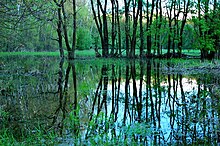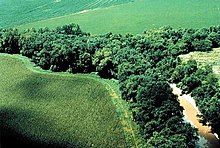| This article needs additional citations for verification. Please help improve this article by adding citations to reliable sources. Unsourced material may be challenged and removed. Find sources: "Riparian forest" – news · newspapers · books · scholar · JSTOR (November 2014) (Learn how and when to remove this message) |

A riparian forest or riparian woodland is a forested or wooded area of land adjacent to a body of water such as a river, stream, pond, lake, marshland, estuary, canal, sink or reservoir.
Etymology

The term riparian comes from the Latin word ripa, 'river bank'; technically it refers only to areas adjacent to flowing bodies of water such as rivers, streams, sloughs and estuaries. However, the terms riparian forest and riparian zone have come to include areas adjacent to non-flowing bodies of water such as ponds, lakes, playas and reservoirs.
Characteristics


Riparian forests are subject to frequent inundation.
Riparian forests help control sediment, reduce the damaging effects of flooding and aid in stabilizing stream banks.
Riparian zones are transition zones between an upland terrestrial environment and an aquatic environment. Organisms found in this zone are adapted to periodic flooding. Many not only tolerate it, but require it in order to maintain health and complete their lifestyles.
Threats
Threats to riparian forests:
- Cleared for agricultural use because of the good soil quality
- Historically, trees used as wood fuel for steamships, steam locomotives, etc.
- Urban development (housing, roads, malls, etc.)
- Grazing
- Mining
- Disrupted hydrology, such as dams and levees, which reduces the amount and/or frequency of flooding
- Invasive species
See also
- Bosque
- Gallery forest
- Management of Pacific Northwest riparian forests
- Riparian zone
- Tugay
- Swamp Oak Forests
References
- Molles, M.C. Jr. (2008). Ecology: Concepts and Applications (4th ed.). New York: McGraw-Hill. p. 291. ISBN 978-0-07-330976-7.
- https://www.waterboards.ca.gov/waterrights/water_issues/programs/bay_delta/docs/cmnt081712/sldmwa/katibahabriefhistoryofriparianforestsinthecentral%20.pdf
External links
- "Assessing the Need for a Riparian Management System (RiMS)"—Iowa State University Extension Bulletin (2002)
This article about environmental habitats is a stub. You can help Misplaced Pages by expanding it. |